Once a land full of thorns, now a flourishing town… Bikaner in Rajasthan is a kingdom whose glory lives on in the red sandstone marvels and home-grown eateries
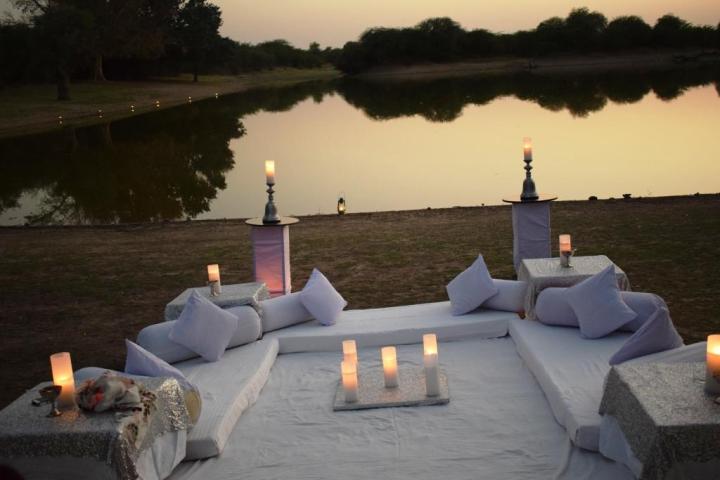
Candles flickered, champagne bubbles tingled, sunrays kissed the water and musical flute notes floated in the breeze… the thorny shrubs disappeared under the dark sky as we ate our dinner at the isolated shores of Darbari Lake. Perhaps it was the hues or maybe the company, but Bikaner certainly wasn’t the staid, laidback city that I expected it to be.
Sitting in the front seat of the car, I almost went right through the windshield in my haste to capture the nilgai in my camera. The sun was about to go down. We had watched the sky change colours during the 30-minute drive to Darbari Lake. The orange and red were fast fading, the nilgai had disappeared. The little lake was lit by lamps at the edge and the candles where our dinner was getting ready. The closer I went to the birds, the faster they flew away into the thorny shrubs. All along, 20-year-old Prakash kept playing melodies on his flute. Our conversation kept moving between goof-ups to fun times, champagne kept flowing and dinner under the stars was just another unforgettable memory.
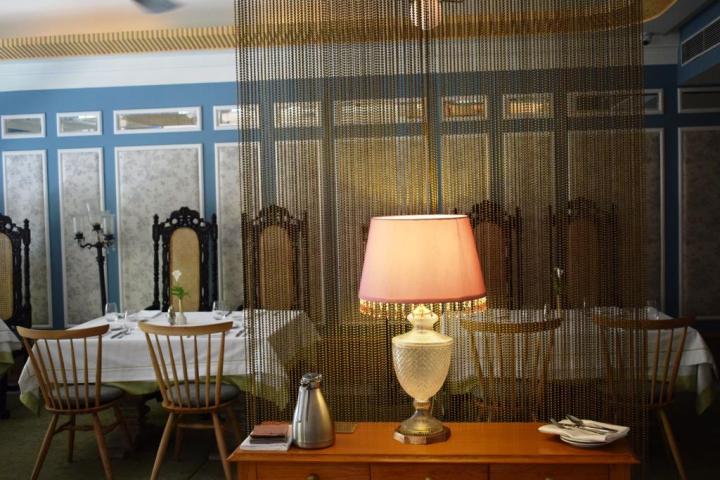
During the last visit, I had enjoyed champagne and snacks at another pasture. That had left me breathless but now it was difficult to decide which was better.But then I was staying at the hot ‘n’ happening Narendra Bhawan, once home to the last Maharaja of Bikaner and now the city’s party ground. The glam caravans from Bollywood keep coming here!
Operated by MRS Hospitality, everything here is reminiscent of the royal roots of Bikaner. “The last Maharaja of Bikaner, Narendra Singh, lived here with almost 500 cows and 90 dogs,” says the group’s president Karan Singh. “The interior is our interpretation of his life.” Spellbinding marble artefacts, designer silks gracing the walls and erstwhile hard bound leather editions spread across the hotel, the traditional red Dulmera sandstone structure is a treasure trove. A little exploration revealed exquisitely designed thematic rooms. I was staying in the plush Regimental room with its velvety sofas and eating nuts every few minutes. Ah! The life of a king, maybe a king’s general. But the taste of the royal flavours was best experienced with curated meals (USP of the hotel) in fancy crockery in a really fancy dining room. Finally, we began to trace the footsteps of the rebellious Rajput prince, Rao Bika, who founded the city in 1488.
Rebellions & Kingdoms
Zooming through the old city with Siddharth Yadav, the group’s vice president, we reached Bikaji ki Tekaree. This chhatri or memorial is a commemoration of the city’s foundation and the spot from where the kingdom began.
In 1465, the young prince was miffed by his father Rao Jodha’s remarks and left in search of his own kingdom. Rao Jodha was the king of Jodhpur and he supported his son’s decision. But in return took a promise that the prince would never come to claim the throne. He was promised some heirlooms on establishing the new kingdom.
Rao Bika landed in ‘jangladesh’ for it was the land of thorny shrubs. If you leave the main town and see the thorny shrubs which we did en route Gajner and Darbari Lake, you won’t be surprised to know that this was once known as ‘jungladesh’. The area comprised Churu, Ganganagar, Bikaner and Hanumangarh. The Jats who occupied it were constantly fighting among themselves. Rao Bika, with the help of ascetic Karni Mata (kuldevi or goddess of the royal clan since then, now has a temple dedicated to her), marked his territory with a temple called Lakshminath and built a fort. The young king now had more enemies, including the neighbouring Rao Shekha of Bhati clan. But the wise Karni Mata arranged his marriage with the local chieftain’s daughter, ending the rivalry and bringing more power to the king.
From where we stood, only a part of the old city wall and the dome of the Lakshminath temple could be seen. Reaching there to meet the divine couple, Vishnu and Lakshmi, we sighted beautiful frescoes on the outer walls and intricate carvings with gold highlights. Nearby was the state gaushala or cow shed. The saga continued as we drove to the Lallgarh Palace Complex, home to the royals even now.
The King’s Footsteps
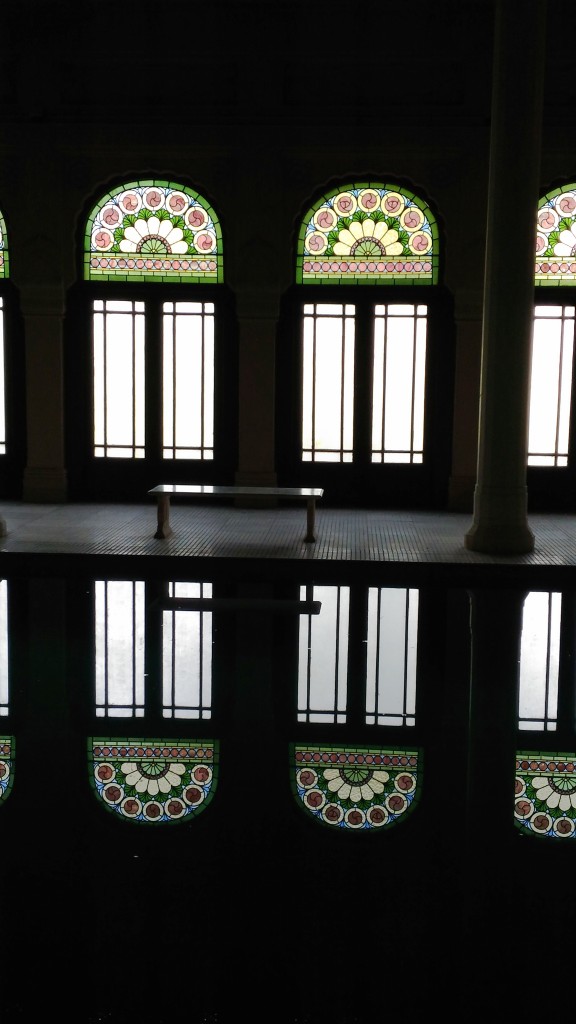
Blown away by the finely carved birds and flowers on the stone walls and the manicured lawns, we entered the Sadul Museum in the complex. After an Instaworthy picture next to the replica of the first royal train of Bikaner, we walked around to see the medals of the royal clan, memories and moments in the many photographs, weapons and more. The complex was built by Sir Ganga Singh, Maharaja of Bikaner, between 1902 and 1926. Designed by British architect Sir Samuel Swinton Jacob, its first guest is believed to be Lord Curzon.
The current royal family also stays here and their residence is obviously off the tourist trail. But Maharaja Ganga Singh’s magnificent home, Laxmi Niwas Palace, is a luxury hotel run by MRS Hospitality. This had taken Maharaja Ganga Singh over 20 years to build. Besides the fine lattice and filigree works, there are artefacts from all over the world here. Blue chandeliers from Belgium, utsa work on the mirrors, clouds on the ceilings, palki of yore, the trophies or heads of the hunted animals, Laxmi Niwas is an experience to savour as we discovered over a sumptuous Marwari lunch here. Another hotel, Lallgarh Palace, is also within the premises.
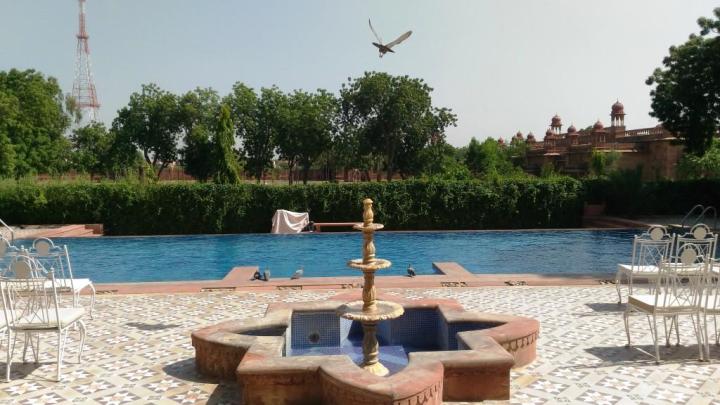
Awed by the intricate latticework, magnificent pillars, brightly coloured frescoes, real gold patterns on walls and artefacts with traditional utsa work, we drove out of the grand Laxmi Niwas Palace to see the cenotaphs at Devi Kund Sagar.
Coming back to the founder, Rao Bika never went back to claim the throne. But after his father’s death in 1489, he asked for the promised heirlooms. The brothers refused and the infuriated king stormed Mehrangarh Fort in Jodhpur. He came back to Bikaner with the heirlooms—the sandalwood ‘Pugal’ throne, a royal umbrella, a sword and a horse of ‘divine origin’. For many centuries the tiff between the clans continued but now there is an ease in relations.
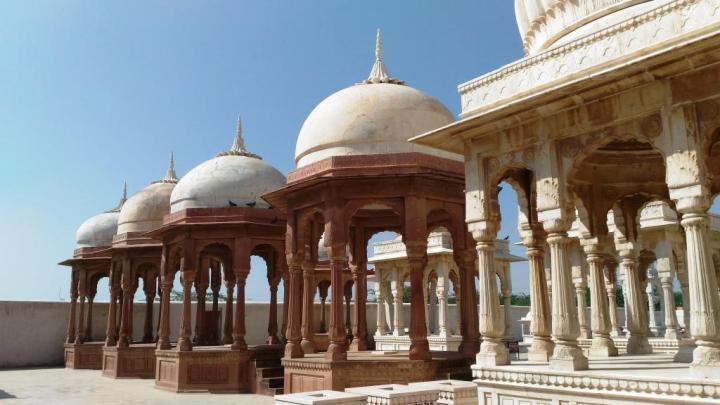
At Devi Kund Sagar, chhatris or royal umbrellas mark the clan’s passage on earth. Some are made in red Dulmera sandstone and others in marble.
Junagarh Fort
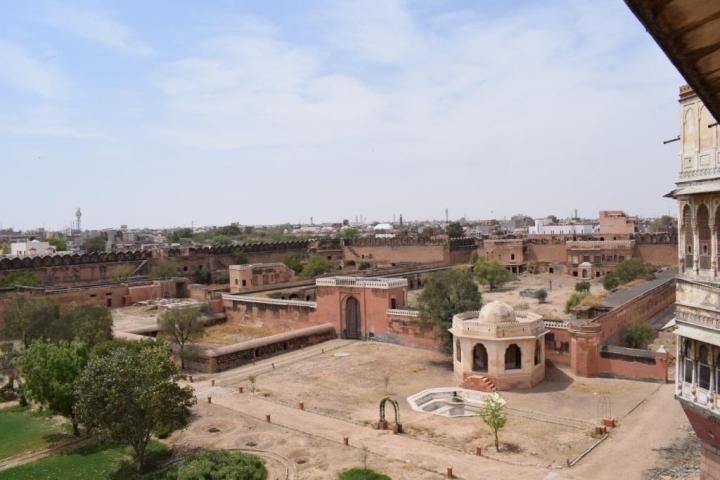
After homes and resting ground, we headed towards Junagarh Fort which was built in the reign of the sixth king of Bikaner Raja Rai Singh, between 1571 and 1611. A few kilometres outside the city, it was originally called Chintamani and renamed when the family moved to Lallgarh Palace in the 20th century. While most forts in Rajasthan are built on hills, this one is not.
The ancient fort area was huge and I had seen the wall ramparts near the Laxmi Narayan temple, quite a distance away from this structure that we were seeing now. Probably this was the centre in those days, our guide Mahavir Singh kept telling us tales. The fort has different European influences along with the traditional craftsmanship. After all, the city has seen many historic changes with different communities and their influences–the British, the Mughals, besides the many nomadic tribes of that area. Despite many attacks, the fort was only captured for a day by Kamran Mirza, the second son of the Mughal emperor Babur who attacked Bikaner in 1534. The city was ruled by Rao Jait Singh then. If you watch the buildings made of red dhulmera sandstone in Bikaner, you will know why it could be the red city.
Raja Rai Singh held the position of an army general during the reign of Akbar and his son Jahangir. He won the land of Mewar and was gifted the jagirs or provinces of Gujarat and Burhanpur. Revenue from these jagirs was used to build the fort. The successive kings kept adding to the magnificent structure.
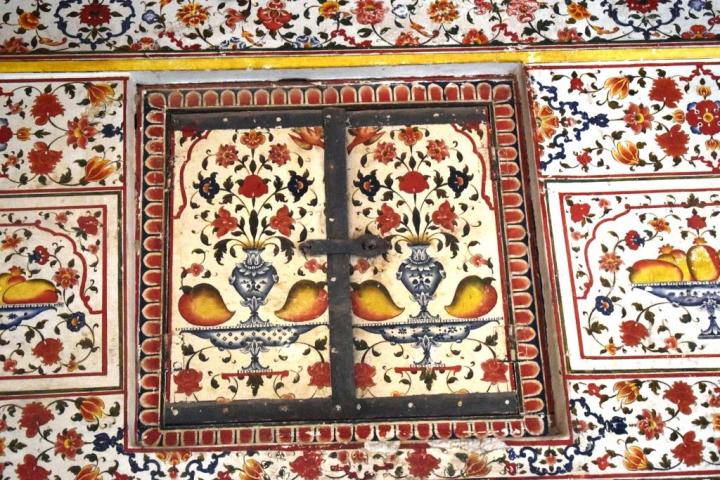
Spread over five acres, the fort has palaces and temples. Walking through the many levels, one is privy to the ancient arts such as the painted walls, the idols of the different gods. The throne area and the chambers of the king and the queen are particularly embellished with gold and the famous Rajasthani art. The ceilings have the famous lac work and the clouds are the main feature in these paintings. Gardens inspired by Versailles and a Shiva temple are open only for the royal clan.
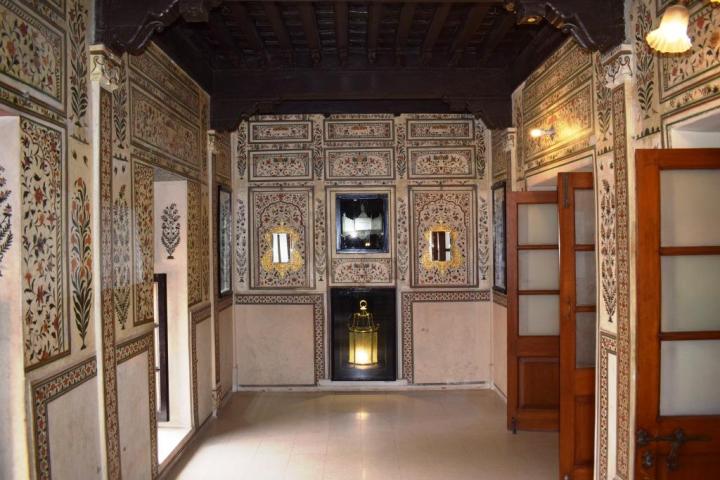
There is also a Prachina Museum in this complex which houses artefacts from the current royal family. You can carry back some souvenirs from the shop.
Old havelis
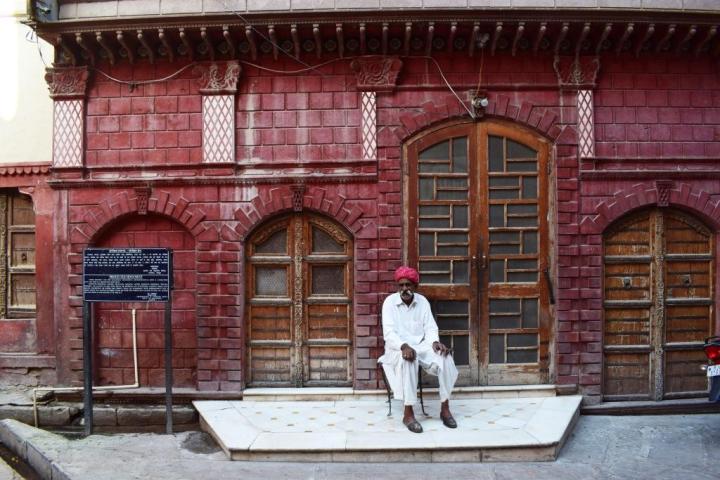
Bikaner formed part of the trade route between Central Asia and the Gujarat coast. But the city grew a lot under the sixth ruler Raja Rai Singh. And the treasures of the merchants lie in the havelis or large housesthat fill the serpentine lanes of the older part of the city. Like the king’s home, here too the carvings and the frescoes leave one spellbound. Unfortunately, most are crumbling, stripped of the treasures. But some red structures stand tall.
A tonga ride through this maze took us back in time. The alleys are a confluence of eras and we saw art deco doorways and windows, tiles with artwork, Nanak Shahi bricks from the Mughal era and breathtaking frescoes. The neighbourhood housed jewellers, carpenters, wool traders and others. The most famous among these were Rampurias, Kotharis and Dagas. Perhaps, the most striking of these structures was the Rampuria Haveli, built in 1933, and had a distinct colonial feel. There are around 400 havelis in the area and there was a campaign to save the heritage structures.
Bridging the ancient world with modern times are goldsmiths in the area who keep the traditional meenakari jewellery art alive. Our ride ended at an ancient haveli owned by a Jain antique dealer, where we had a sumptuous Jain meal.
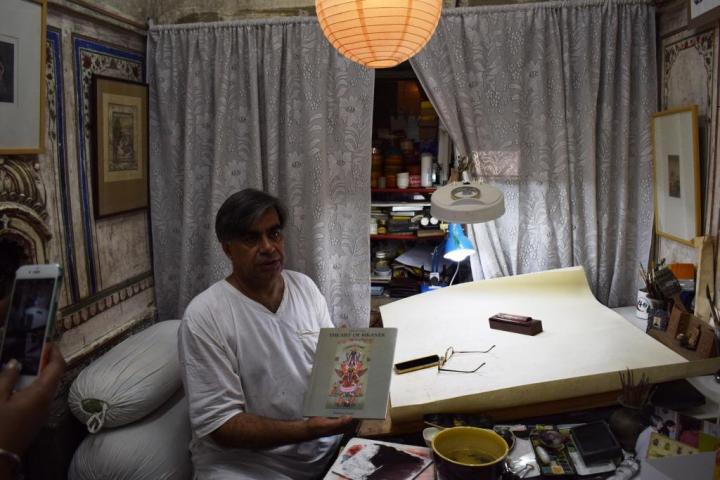
Back at the hotel, I browsed through the gallery housing miniatures by award-winning artist Mahaveer Swami. Along with his son, he is keeping the Bikaner style of art alive with workshops in India and abroad and travels for exhibitions and residencies. The treasure of paintings is enormous for the humble man who has been awarded the Padam Shree and at the entrance of his home a huge certificate on the wall will tell you that. Coming from a lineage of miniature artists, even today he paints in the same room that his father painted in. Every morning, he prays to his family deity seated in the small shrine in the wall of this room, which is about 250 years old. All around him are paintings and each could take about a year or more to finish, depending on what’s being painted. Most of the paintings are focussed on the mythological tales and gods and goddesses of India. He is even the author of a book titled The Art of Bikaner. He has worked with painters from other countries too on special projects and is currently working on one with plants. His works can be found in MOSA, Belgium and more museums across the world. Opening the cupboards of natural colours, the artist introduced us to his son who works with him.
It was time to say goodbye but not without a sip of the famous gin and tonic laced with rose petals.
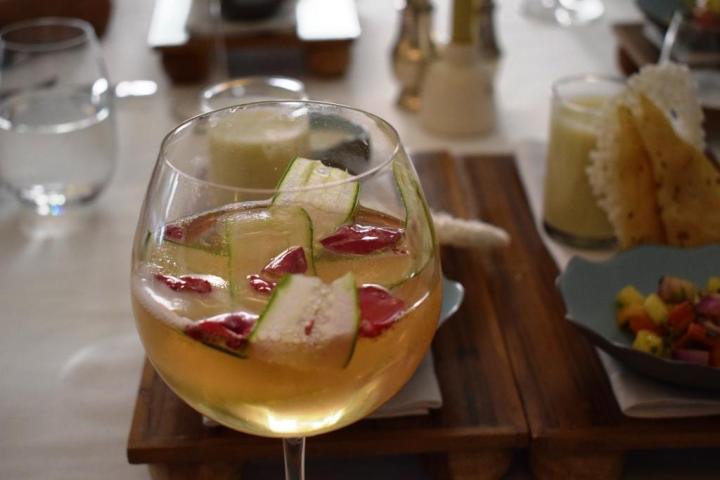
More attractions
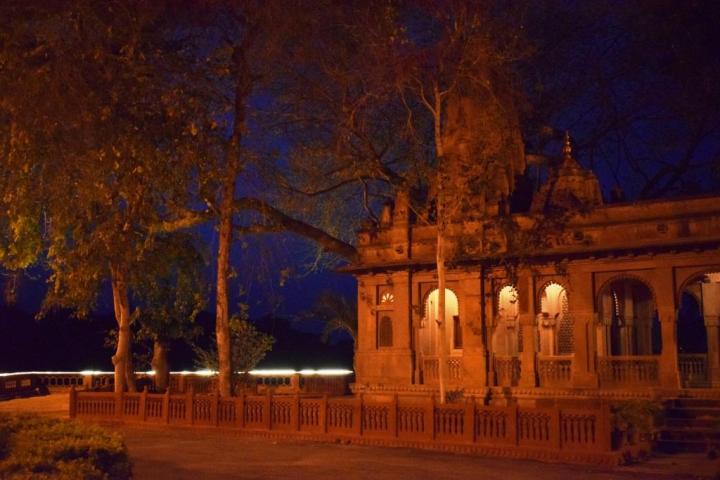
Gajner Palace & Wildlife Sanctuary: Maharaja Ganga Singh’s hunting lodge is now a heritage hotel. It was connected to Bikaner Palace by rail in 1922. The lodge has played host to the Prince of Wales in 1905, Lord Erwin in 1927 and also the Viceroy of India Lord Mountbatten.
Siddharth zoomed us to the Gajner Wildlife Sanctuary. As the sun set, we had to forgo our plan of a safari but took a round of Gajner Palace which is now a heritage hotel. Aroma of sandalwood and camphor flitted around us. We were standing in front of the temple and the distant sounds from the waters beyond kept distracting us. A party was going on. The open bar in the courtyard, drinks under the starlit sky, seemed like an exotic move. But we were in a hurry.
Karni Mata temple: The kuldevi resides here with an army of rats. Sighting a white one amid the black army is considered auspicious.
National Research Centre on Camel: Housing over 300 camels, this is a good place to watch the tall ones up close. Do dig into the camel milk treats such as ice cream, kulfi, tea, coffee.
Where to Shop & Eat in Bikaner
- Kote Gate market is the traditional shopping zone.
- Right outside the railway station is the shop called Chotu Motu Joshi where you can eat dana methi kairi and poori. Take back some moth bhujia and rasgullas. This family’s roots are as old as the city.
- Drink natural sherbets in kulhad at Chunnilal Tanwar’s shop at Old Jail Road. Offering eco-friendly flavours since 1939, you can take a pick from rose, white rose, laung or clove, khus, kesar milk, paan, elaichi, saunf, kewra.
- At the Ambedkar circle is Vardhman café, which offers delicious gulkand milkshake. With five decades in the ice-cream business, this family offers some baked goodies too.
Best time to visit Bikaner
October to March. A camel fair is held in January.
Stay: Narendra Bhawan, Karni Nagar, Gandhi Colony, Bikaner 334001, Rajasthan (India); Contact: +91-7827-151 151, email: reservation@narendrabhawan.com
How to reach: The best way is by train. You can take the overnight trains from Delhi. We took the Dee Bkn S F Ex – 12457 which leaves from Sarai Rohilla station at 23:35 and arrives at 7:10. The hotel arranges a pick-up and sends an SMS with the details. Else, you can take the flight to Bikaner.
From 2016 to 2019, I have written about Bikaner in many publications. This article was published in Dialogue (October 2018), the Delhi Airport magazine.
Do share your views and thoughts in the comments section below and like, share and subscribe to the blog.

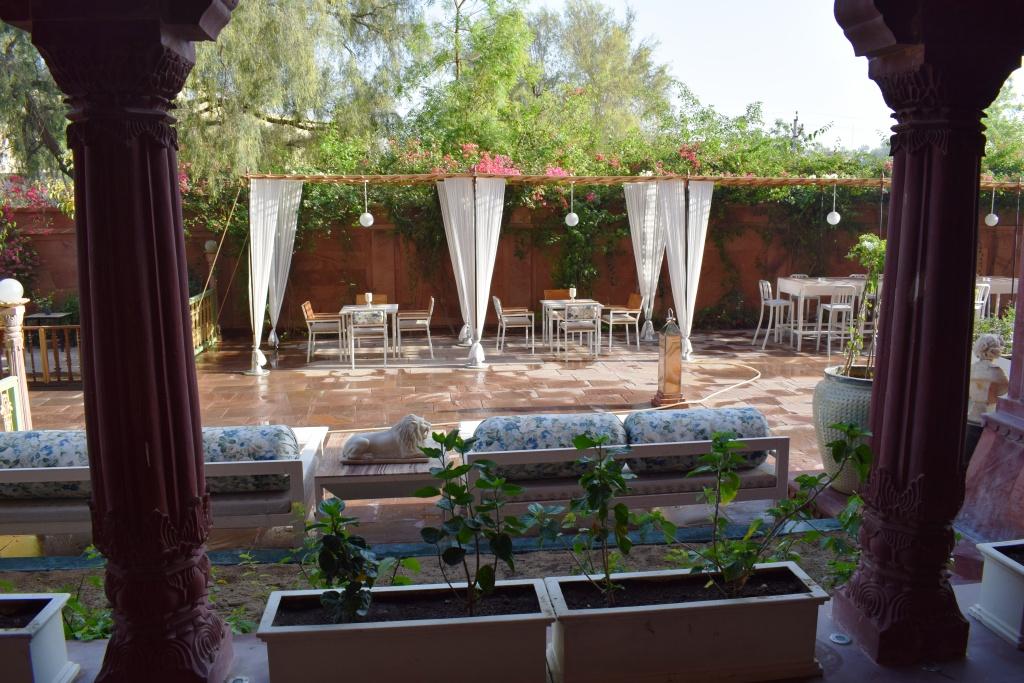
Nice post. Highly helpful for travellers who want to visit these places in Bikaner. Very informative and well written. Keep it up.
LikeLiked by 2 people
I have always been enchanted by Rajasthani culture, it’s forts, historical places and palaces. Bikaner is another place I wish to visit now
LikeLiked by 1 person
I am sure you will love it, it’s absolutely historic with rich heritage sturctures.
LikeLike
I love visiting Rajasthan as I have spent a big chunk of my childhood there. You have given many reasons to fall in love with Bikaner again 🙂
LikeLiked by 1 person
Glad to have rekindled happy memories
LikeLike
The more I read about India, the more I want to visit it. I have to confess that I haven’t heard of Bikaner before. From what you are describing, this seems like a very attractive city, with an old and interesting history. The rich and colorful frescoes inside the Junagarh Fort definitely caught my eye. Would love to visit it someday.
LikeLiked by 1 person
I hope you do get to visit it.
LikeLike
Thank you for this extensive post on Bikaner. Going through oodles of nostalgia with you 🙂 Bikaner is an underdog in terms of tourism, so it’s treasures are even more enjoyable.
LikeLiked by 1 person
Glad it brought back good memories
LikeLike
What lovely views, and the gin and tonic looks so luxe! India is so rich with history, it’s wealth of beautiful scenery and buildings never fail to impress me. Thank you for including the best times to visit!
LikeLiked by 1 person
Am glad you enjoyed it!
LikeLike
There’s so much Bikaner has to offer.
Loved reading your detailed post.
Worth spending more time in this city on my next rajasthan trip
LikeLiked by 1 person
Have a good trip
LikeLike
Always great when a visit is so much better than you expected. Your trip around Bikaner sure got you some beautiful sights. I love when interiors like those inside the Junagarh Fort are open for viewing. It gives you a view of how people lived. And how fun to take a Tonga ride and be taken back in time. It might be fun to visit for the camel fair in January.
LikeLiked by 1 person
Oh yes! RAJASTHAN IS BEST EXPLORED IN winter as it is a desert state.
LikeLike
I have been to Bikaner but never stayed in any royal place yet. I would love to visit Bikaner and want to stay here. Thanks for such glam info.
LikeLiked by 1 person
I hope you go soon
LikeLike
I have been to Udaipur thrice and Ajmer and Mount Abu in Rajasthan. After reading this article I want to plan a trip to Bikaner and use this article as an itinerary builder.
LikeLiked by 1 person
Have a good trip!
LikeLike
Bikaner truly is a gem. There are so many attractions there. It was so interesting to know about the history of the place, about the young prince who left his kingdom. I have not properly explored Rajasthan yet. When I do it, Bikaner will definitely me on my list.
LikeLiked by 1 person
Rajasthan is a bright state with many precious archtiectural marvels.
LikeLike
Bikaner has always been on my list and I do hope to visit it someday. I love the palaces and forts. I will surely visit Junagarh Fort as that looks stunning. Rajasthan has so much of history.
LikeLiked by 1 person
Keep 3 days for this trip. Lots of roaming around and lots of royal museums etc
LikeLike
You’ve put together everything that makes Bikaner, the cultural heritage and architectural marvel that it is, so amazingly. Thanks for sharing such close, personal insights.
LikeLiked by 1 person
So glad you found it useful
LikeLike
Your articles are as captivating as a great book. I have the impression that I moved in time and place to colorful Rajasthan. The story about the last Maharaja of Bikaner, Narendra Singh, who lived with almost 500 cows and 90 dogs, is terrific. I would love to visit Devi Kund, royal cenotaphs, and Junagarh Fort. Its interiors are so impressive and photogenic. I hope to go back one day to India. Unfortunately, during my three previous visits, I had no time to visit Bikaner.
LikeLiked by 1 person
Thank you for the appreciation. I hope you do get to visit Bikaner.
LikeLike
Really enjoyed this virtual tour and the informative snippets of the era gone bye. I am fascinated by history and wish to travel to Bikaner .
LikeLiked by 1 person
I hope you enjoy your vacation there
LikeLike
Great documentation…I so want to document the Miniature art and Havelis of Bikaner, hope to travel there soon… Bikaner is complete untouched by me …Thanks for this lovely documentation…bookmarked it already
LikeLiked by 1 person
I hope you enjoy your trip
LikeLike
Wow – Bikaner has such a rich and long history. I love the picture of the royal cenotaphs of Rao Bika and his family. But the tiles of the Junaghar Fort look stunning too. All the better you could stay at this beautiful hotel!
LikeLike
Wow! I would love to visit Bikaner. This place is wonderful. Happy to know there is beautiful accommodation available.
Super love your photos. I did not realize there is so much to see here. A visit to the Gajner Palace and Wildlife is a good idea too. I am pretty sure my husband would be happy. As for me, a dinner by Darbari Lake is enough reason to visit.
LikeLiked by 1 person
Oh yes! That’s one romantic dinner…you must have that
LikeLike
Palaces in Rajasthan are a common sight. Most of these belong to the Rajputs who occupied many states of Rajasthan until 1947. They were the royal families and their palaces and legacies are strewn throughout the now united state of Rajasthan. Today most of these palaces have been converted to heritage hotels in Rajasthan. The grandiose buildings reflect the sumptuous life of the Rajas. As tourists keep on coming across one palace after another they realize that the state is rightfully called the land of the Rajas.
https://www.indianetzone.com/23/palaces_rajasthan.htm
LikeLiked by 1 person